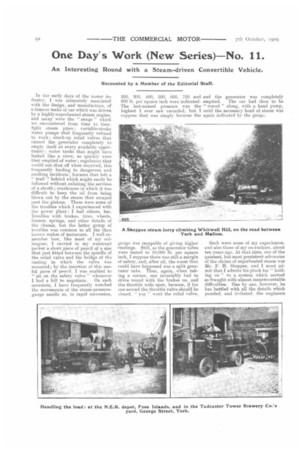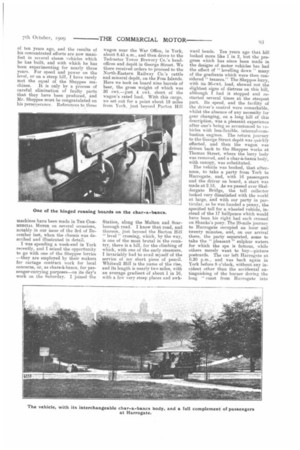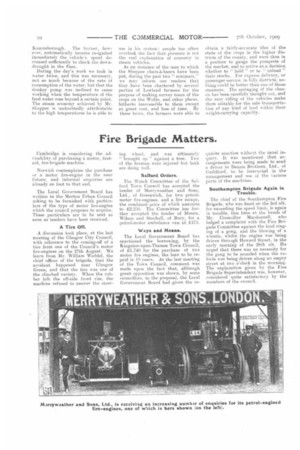One Day's Work (New Series)—No. 11.
Page 4

Page 5

Page 6

If you've noticed an error in this article please click here to report it so we can fix it.
An Interesting Round with a Steam-driven Convertible Vehicle.
Recounted by a Member of the Editorial Staff.
In the early days of the motor industry. I wa.s intimately associated with the design, and manufacture, of a famous make of ear which was driven by a highly-superheated steam engine, and many were the " snags " which we encountered from time to time. Split steam pipes ; variable-stroke water pumps that frequently refused to work; stuck-up relief valves that caused the generator completely to empty itself at every available opportunity; water tanks that might have leaked like a sieve, so quickly were they emptied of water ; regulators that would not shut off when required, this frequently leading to dangerous and exciting incidents ; burners that left a " trail " behind which might easily he followed without enlisting the services of a sleuth; crankcases in which it was difficult to keep the oil from being blown out by the steam that escaped past the pistons. These were some of the troubles which I experienced with the power plant; I had others, -toe. Troubles with brakes, tires, wheels, frames, springs, and other details of the chassis, but the latter group of troubles was common to all the then known makes of motorcars. I well remember how, like most of my colleagues, I carried in my waistcoat pocket a short piece of pencil of a size that just fitted between the spindle of the relief valve and the bridge of the casting in which the valve was mounted ; by the insertion of this useful piece of pencil. I was enabled to " sit on the safety valve " whenever I had a hill to negotiate. On such occasions, I have frequently watched the movements of the steam-pressuregauge needle as, in rapid succession, 200, 300, 400, 500, 600, 700 and 800 lb. per square inch were indicated. The last-named pressure was the highest I ever saw recorded, but I suppose that was simply because the
gauge was incapable of giving higher readings. Still, as the generator tubes were tested to 10,000 lb. per square inch, I suppose there was still a margin of safety, and, after all, the worst that could have happened was a split generator tube. Then, again, when taking a corner, one invariably had to drive round with the brakes on, and the throttle wide open, because, if for one second the throttle valve should be closed, " pop went the relief valve, and the generator was completely emptied. The car had then to be " rowed " along, with a hand pump, until the necessary head of steam was again indicated by the gauge.
Such were some of my experiences, and also those of my co-workers, about ten years ago. At that time, one of the quietest, but most persistent advocates of the claims of superheated steam was Mr. F. H. Sheppee, and I must admit that I admire his pluck for " holding on " to a system which seemed so fraught with almost insurmountable difficulties. One by one, however, he has battled with all the details which puzzled. and irritated, the engineers
of ten years ago, and the results of his concentrated efforts are now manifest in several steam vehicles which he has built, and with which he has been experimenting for nearly three years. For speed and power on the level, or on a steep hill, I have rarely met the equal of the Sheppee ma chines. It is only by a process of careful elimination of faulty parts that they have been produced, and Mr. Sheppee must be congratulated on his perseverance. References to these
machines have been made in TILE COMMERCIAL MOTOR on several occasions, notably in our issue of the 3rd of December last, when the chassis was described and illustrated in detail.
I was spending a week-end in York recently, and I seized the opportunity to go with one of the Sheppee lorries —they are employed by their makers for cartage contract work for local concerns, or, as chars-a-banes, for passenger-carrying purposes—on its day's work on the Saturday. I joined the
wagon near the War Office, in York, about 8.45 a.m., and then drove to the Tadcaster Tower Brewery Co.'s headoffices and depot in George Street. We there received orders to proceed to the North-Eastern Railway. Co.'s cattle and mineral depOt, on the Foss Islands. Here we took on board nine barrels of beer, the gross weight of which was 36 cwt.—just 4 cwt. short of the wagon's rated load. With this cargo, we set out for a point about 13 miles from York, just beyond Parton Hill
Station, along the Malton and Scarborough road. I know that road, and thereon, just beyond the Barton Hill " level " craning, which, by the way, is one of the most brutal in the country, there is a hill, for the climbing of which, with one of the early steamers, I invariably had to avail myself of the service of my short piece of pencil. Whitwell Hill is the name of the rise, and its length is nearly two miles, with an average gradient of about 1 in 16, with a few very steep places and awk ward bends. Ten years ago that hill looked more like 1 in 2, but the progress which has since been made in the designs of motor vehicles has had the effect of "levelling down " many of the gradients which were then considered " teazers." The Sheppee lorry, with its 36-cwt. load, showed not the slightest signs of distress on this hill, although I had it stopped and restarted several times at the steepest part. Its speed, and the facility of the driver's control were remarkable, whilst the absence of any necessity for gear changing, on a long hill of this description, was a pleasant experience after one's being so accustomed to vehicles with less-flexible, internal-combustion engines. The return journey to the George Street depot was quickly effected, and then the wagon was driven back to the Sheppee works at Thomas Street, where the lorry body was removed, and a char-i-bancs body, with canopy, was substituted.
The vehicle was booked, that afternoon, to take a party from York to Harrogate, and, with 16 passengers and the driver on board, a start was made at 2.15. As we passed over Skeldergate Bridge, the toll collector looked very dissatisfied with the world at large, and with our party in particular, as he was handed a penny, the specified toll for a wheeled vehicle, instead of the 17 halfpence which would have been his right had each crossed on Shanks's pony. The 20-mile journey to Harrogate occupied an hour and twenty minutes, and, on our arrival there, the party separated, some to take the " pleasant " sulphur waters for which the spa is famous, while others merely went to buy—picture postcards. The car left Harrogate at 6.30 p.m., and was back again in York before 8 o'clock, without any incident other than the accidental extinguishing of the burner during the long " coast from Harrogate into
Knaresborough. The burner, however, automatically became re-ignited immediately the vehicle's speed decreased sufficiently to check the downdraught in the flues.
During the day's work we took in water twice, and this was necessary, not so much because of the rate of consumption of the water, but that the donkey pump was inclined to cease working when the temperature of the feed water rose beyond a certain point. The steam economy achieved by Mr. Sheppee is undoubtedly attributable to the high temperatures he is able to
11Se ju his system : people too often overlook the fact that pressure is not the real explanation of economy in steam vehicles.
As an instance of the uses to which the Sheppee chars-h-bancs have been put, during the past two " summers," we may inform our readers that they have been chartered by several parties of Lowland farmers for the purpose of making survey tours of the crops on the Wolds, and other places, hitherto inaccessible to them except at great cost, and loss of time. By these tours, the farmers were able to obtain a fairly-accurate, idea of the state of the crops in the higher districts of the county, and were thus in a position to gauge the prospects of the market, and to arrive at a decision whether to " hold " or to " unload " their stocks. For express delivery, or passenger service, in hilly districts, nothing could be better than one of these steamers. The springing of the chassis has been carefully thought out, and the easy riding of the vehicles make them suitable for the safe transportation of any kind of load within their weight-carrying capacity.






















